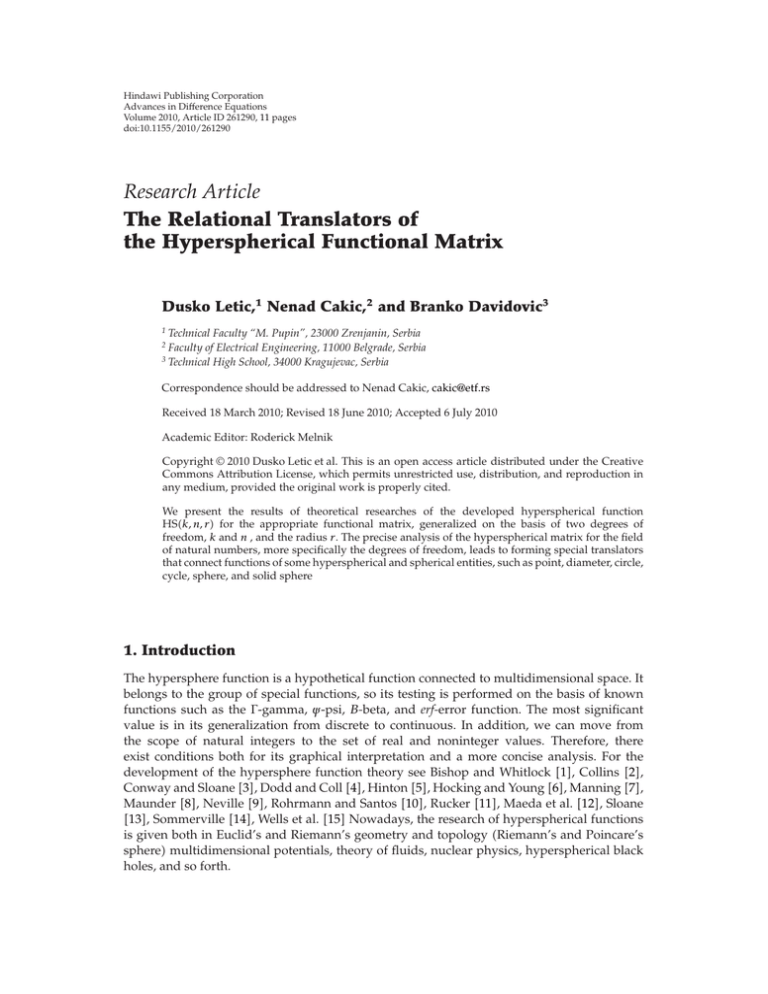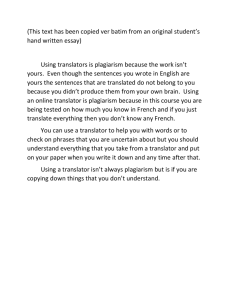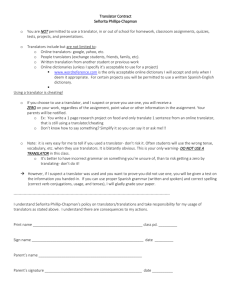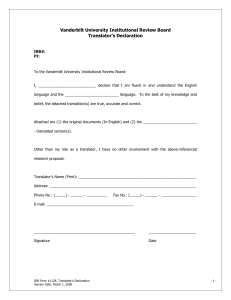Document 10833039
advertisement

Hindawi Publishing Corporation
Advances in Difference Equations
Volume 2010, Article ID 261290, 11 pages
doi:10.1155/2010/261290
Research Article
The Relational Translators of
the Hyperspherical Functional Matrix
Dusko Letic,1 Nenad Cakic,2 and Branko Davidovic3
1
Technical Faculty “M. Pupin”, 23000 Zrenjanin, Serbia
Faculty of Electrical Engineering, 11000 Belgrade, Serbia
3
Technical High School, 34000 Kragujevac, Serbia
2
Correspondence should be addressed to Nenad Cakic, cakic@etf.rs
Received 18 March 2010; Revised 18 June 2010; Accepted 6 July 2010
Academic Editor: Roderick Melnik
Copyright q 2010 Dusko Letic et al. This is an open access article distributed under the Creative
Commons Attribution License, which permits unrestricted use, distribution, and reproduction in
any medium, provided the original work is properly cited.
We present the results of theoretical researches of the developed hyperspherical function
HSk, n, r for the appropriate functional matrix, generalized on the basis of two degrees of
freedom, k and n , and the radius r. The precise analysis of the hyperspherical matrix for the field
of natural numbers, more specifically the degrees of freedom, leads to forming special translators
that connect functions of some hyperspherical and spherical entities, such as point, diameter, circle,
cycle, sphere, and solid sphere
1. Introduction
The hypersphere function is a hypothetical function connected to multidimensional space. It
belongs to the group of special functions, so its testing is performed on the basis of known
functions such as the Γ-gamma, ψ-psi, B-beta, and erf-error function. The most significant
value is in its generalization from discrete to continuous. In addition, we can move from
the scope of natural integers to the set of real and noninteger values. Therefore, there
exist conditions both for its graphical interpretation and a more concise analysis. For the
development of the hypersphere function theory see Bishop and Whitlock 1, Collins 2,
Conway and Sloane 3, Dodd and Coll 4, Hinton 5, Hocking and Young 6, Manning 7,
Maunder 8, Neville 9, Rohrmann and Santos 10, Rucker 11, Maeda et al. 12, Sloane
13, Sommerville 14, Wells et al. 15 Nowadays, the research of hyperspherical functions
is given both in Euclid’s and Riemann’s geometry and topology Riemann’s and Poincare’s
sphere multidimensional potentials, theory of fluids, nuclear physics, hyperspherical black
holes, and so forth.
2
Advances in Difference Equations
2. Hypersphere Function with Two Degrees of Freedom
The former results see 4–30 as it is known present two-dimensional surface-surfs,
respectively, three-dimensional volume-solids geometrical entities. In addition to certain
generalizations 27, there exists a family of hyperspherical functions that can be presented
in the simplest way through the hyperspherical matrix Mk×n , with two degrees of freedom
k and n k, n ∈ R, instead of the former presentation based only on vector approach on
the degree of freedom k. This function is based on the general value of integrals, and so we
obtain it’s generalized form.
Definition 2.1. The generalized hyperspherical function is defined by
√
2 π k r kn−3 Γk
HSk, n, r Γk n − 2Γk/2
k, n ∈ R,
2.1
where Γz is the gamma function.
On this function, we can also perform “motions” to the lower degrees of freedom by
differentiating with respect to the radius r, starting from the nth, on the basis of recurrence
∂
HSk, n, r HSk, n − 1, r,
∂r
HSk, n 1, r r
HSk, n, rdr.
2.2
0
The example of the spherical functions derivation is shown in Figure 1. The second
n 2 degree of freedom is achieved, and it is one level lower than the volume level n 3. Several fundamental characteristics are connected to the sphere. With its mathematically
geometrical description, the greatest number of information is necessary for a solid sphere as
a full spherical body. Then we have the surface sphere or surf-sphere, and so forth.
The appropriate matrix Mk×n k, n ∈ R is formed on the basis of the general
hyperspherical function, and here it gives the concrete values for the selected submatrix
11 × 12 n −2, −1, . . . , 6; k −3, −2, . . . , 5 as shown in Figure 2.
3. Translators in the Matrix Conversion of Functions
A more generalized relation which would connect every element in the matrix, Figures 3
and 4 both discrete and/or continual ones, can be defined on the basis of relation quotient
of two hyperspherical functions, one with increment of arguments dimensions—degrees of
freedom Δk, Δn, ∈ N, that is, the assigned one—while the other would be the starting one
the referred one. On the basis of the previous definition, the translator is
ϑΔk, Δn, 0 HSk Δk, n Δn, r
HSk, n, r
√
n − 2ΓΔk 2
k
Γ
.
ΓkΓk n Δk Δn − 2Γk Δk/2
2
π Δk r ΔkΔn Γk
3.1
Advances in Difference Equations
3
Surf column
Operations
Solid column
2r
n
k
k1
2
⇐
d
2r
dr
k2
2πr
⇐
d
πr 2
dr
4πr 2
⇐
d 4 3
πr
dr 3
k3
πr 2
4 3
πr
3
n2
n3
Figure 1: Moving through the vector of real surfaces left column, deducting one degree of freedom k of
the surface sphere we obtain the circumference, and for two degrees we get the point 2. Moving through
the vector of real solids right column, that is, by deduction of one degree of freedom k from the solid
sphere, we obtain a circle disc, and for two degrees of freedom, we obtain a line segment or diameter.
−2
⎡ 1260
MHSk×n ⎢ π2r8
⎢
⎢
⎢
⎢ 0
⎢
⎢
⎢ 120
⎢−
⎢
⎢ πr 6
⎢
⎢
⎢
⎢ 0
⎢
⎢
⎢
⎢
⎢ 0
⎢
⎢
⎢
⎢
⎢ 0
⎢
⎢
⎢
⎢
⎢ 0
⎢
⎢
⎢
⎢
⎢ 0
⎢
⎢
⎢
⎢
⎣ 64π 2
−1
−
0
1
2
3
6
π2r5
3
2π 2 r 4
0
0
1
πr 2
1
πr
4
180
π2r7
30
π2r6
0
0
0
6
πr 4
2
πr 3
0
0
0
0
1
0
0
0
2
2r
0
0
2π
2πr
πr 2
24
πr 5
−
0
12π 2
64π 2 r
8π
12π 2 r
32π 2 r 2
−
8πr
6π 2 r 2
2 3
32π r
3
−
−
1
2π 2 r 3
3
4πr 2
4πr
3
2π 2 r 3
π2r4
2
2 4
8π r
3
2 5
8π r
15
1
4π 2 r 2
5
1
4π 2 r
1
−
2π
−
6
⎤
Undef.
⎥
⎥
r ⎥
⎥
0
−
⎥
2π ⎥
⎥
⎥
Undef. Undef. Undef.⎥
⎥
⎥
⎥
r3 ⎥
r2
⎥
⎥
r
2
6 ⎥
⎥
⎥
3
4
⎥
r
r
⎥
r2
3
12 ⎥
⎥
⎥
πr 4
πr 5 ⎥
πr 3
⎥
3
12
60 ⎥
⎥
⎥
πr 4
πr 5
πr 6 ⎥
⎥
3
15
90 ⎥
⎥
⎥
π2r5
π2r6
π2r7 ⎥
⎥
⎥
10
60
420 ⎥
⎥
2 6
2 7
2 8 ⎥
4π r
4π r
π r ⎦
45
315
630
n
k
−3
−2
−1
n∈N
0
2.3
1
2
3
4
5
k∈N
Figure 2: The submatrix HSk, n, r of the function that covers one area of real degrees of freedom k, n ∈
R. Also noticeable are the coordinates of six sphere functions undef. are nondefined, predominantly of
singular value, and 0 are zeros of this function.
4
Advances in Difference Equations
n−1
n
n1
k−1
k
HS n, k, r
k1
Figure 3: The position of the reference element and its surrounding in the hypersphere matrix when
Δk, Δn ∈ { 0, 1, −1}.
Note 3.1. In the previous expression we do not take into consideration the radius increase as
a degree of freedom, so Δr 0. The defining function HSk Δk, n Δn, r thus equals
HSk Δk, n Δn, r ϑΔk, Δn, 0 · HSk, n, r.
3.2
This equation can be expressed in the form
√
k Δk 1
2kΔk π kΔk−1 r knΔkΔn−3
·Γ
HSk Δk, n Δn, r .
Γk n Δk Δn − 2
2
3.3
Every matrix element as a referring one can have in total eight elements in its neighbourhood,
and it makes nine types of connections one with itself in the matrix plane Figure 3.
Considering that two degrees of freedom have a positive or negative increment in this case
integer, the selected submatrix is representative enough from the aspect of the functions
conversion in plane with the help of the translator ϑΔk, Δn, 0.
Since the accepted increments are threefold Δk, Δn ∈ {0, 1, −1}, and connections
are established only between the two elements, the number of total connections in the
representative submatrix is 32 9. All relations of this submatrix and the translators that
enable those connections can now be summarised in Table 1.
4. Generalized Translators of the Hyperspherical Matrix
In this section the extended recurrent operators include one more dimension as a degree of
freedom, which is the radius r. If the increment and/or reduction is applied on this argument
as well, the translator ϑ will get the extended form.
Advances in Difference Equations
5
Table 1
Translators
Formula
Destination function
1
√
2r π
Γk/2 1
·
k n − 2 Γk 1/2
HSk, n, r
1
ϑ0, 0, 0
2
ϑ1, 0, 0
3
ϑ0, 1, 0
r
kn−2
HSk, n 1, r
4
ϑ1, 1, 0
√
Γk/2 1
2 πr 2
·
k n − 1k n − 2 Γk 1/2
HSk 1, n 1, r
5
ϑ−1, 0, 0
Γk/2
kn−3
·
√
2 π r Γk 1/2
HSk − 1, n, r
6
ϑ0, −1, 0
7
ϑ−1, 1, 0
8
ϑ1, −1, 0
√
Γk/2 1
2 π·
Γk 1/2
HSk 1, n − 1, r
9
ϑ−1, −1, 0
Γk/2
k n − 3k n − 4
·
√
Γk 1/2
2 π r2
HSk − 1, n − 1, r
kn−3
r
1
Γk/2
√ ·
2 π Γk 1/2
HSk 1, n, r
HSk, n − 1, r
HSk − 1, n 1, r
Definition 4.1. The translator ϑ is defined with
ϑ±Δk, ±Δn, ±Δr HSk ± Δk, n ± Δn, r ± Δr
HSk, n, r
π ±Δk/2 r ± Δrkn±Δk±Δn−3 Γk n − 2Γk ± Δk
k
kn−3
·Γ
.
2
r
ΓkΓk n ± Δk ± Δn − 2Γk ± Δk/2
4.1
Since all the three increments can be positive or in symmetrical case negative in reduction,
expression 3.1 is extended and is reduced to relation 4.1, where the differences
Δk, Δn, Δr are the increment values or reduction of the variables k, n, and r in relation
to the referent coordinate HS-function in the matrix. All three variables can be real
numbers Δk, Δn, Δr ∈ R. The obtained expression ϑ±Δk, ±Δn, ±Δr is a more generalized
translator, a more generalized functional operator, and in that sense it will be defined as
the generalized translator. When, besides the unitary increments of the degree of freedom
Δk ∈ {0, 1, −1} and Δn ∈ {0, 1, −1}, we introduce the radius increment Δr ∈ {0, 1, −1}, the
number of combinations becomes exponential Table 2, and it is 33 27.
The schematic presentation of “3D motions” through the space of block-submatrix and
locating the assigned HS function on the basis of translators and the starting hyperspherical
function is given in Figure 4.
6
Advances in Difference Equations
Table 2
ϑ0, 0, 0
ϑ0, −1, 0
ϑ1, 1, 0
ϑ−1, 0, 0
ϑ−1, −1, 0
ϑ0, 0, 1
ϑ0, −1, 1
ϑ1, 1, 1
ϑ−1, 0, 1
ϑ−1, −1, 1
ϑ0, 0, −1
ϑ0, −1, −1
ϑ1, 1, −1
ϑ−1, 0, −1
ϑ−1, −1, −1
ϑ0, 1, 0
ϑ1, 0, 0
ϑ1, −1, 0
ϑ−1, 1, 0
ϑ0, 1, 1
ϑ1, 0, 1
ϑ1, −1, 1
ϑ−1, 1, 1
ϑ0, 1, −1
ϑ1, 0, −1
ϑ1, −1, −1
ϑ−1, 1, −1
HS k − 1, n − 1, r 1
HS n, k, r
−k
−r
−n
r
n
k
Figure 4: The example of the position of the referent and assigned element of the nested HS function in
the block-matrix in the space of the selected hyperspheric block-matrix.
According to the translator ϑ−1, −1, 1 that includes three arguments, and in view
of it “covering the field” of the block-submatrix Mk,n,r according to Figure 4, we have the
following function:
HSk − 1, n − 1, r 1 ϑ−1, −1, 1HSk, n, r.
4.2
Examples 4.2. Depending on which level we observe, the translator can be applied on blockmatrix, matrix, or vector relations. The most common is the recurrent operator for the
elements of columns’ vector. Then, it is usually reduced onto one variable and that is the
degree of freedom k. If the increment is an integer and Δk 2, the recurrent relation for any
element of the nth column is defined as
ϑ2, 0, 0 2πr 2 k 1
.
k n − 1k n − 2
4.3
If the relation is restricted to n 2, that is, on the vector particular to this degree of freedom
and on the increment Δk 2, the translator can be simplified as
ϑ2, 0, 0 HSk 2, 2, r 2πr 2
.
HSk, 2, r
k
4.4
Advances in Difference Equations
7
For the unit radius this expression can be reduced to the relation
HSk 2, 2, 1 2π
HSk, 2, 1.
k
4.5
If we analyze the relation for the vector with the degree of freedom n 3 and the increment
Δk 2, the translator now becomes
ϑ2, 0, 0 2πr 2
.
k2
4.6
On the basis of the previous positions and results, we define two recurrent operators for
defining the assigned functions
1 for the matrix
HSk ± Δk, n ± Δn, r ϑ±Δk, ±Δn, 0 · HSk, n, r,
4.7
2 and for the block-matrix Figure 3
HSk ± Δk, n ± Δn, r ± Δr ϑ±Δk, ±Δn, ±Δr · HSk, n, r.
4.8
As the recurrent operator is generalized, the increments can also be negative ones and
noninteger; so, for example, for the block matrix recursion, with the selected increments
Δk 1/5, Δn −1/4, and Δr 1/7, the operator has a more complex structure
ϑ
1 1 1
,− ,
5 4 7
Γk n − 2Γk/2 Γk 1/5
π 1/10 r 1/7kn−61/10
.
ΓkΓ5k 1/10 Γk n − 41/20
r kn−3
4.9
5. Conversion of the Basic Spheric Entities
Example 5.1. All relations among the six real geometrical sphere entities are presented on the
basis of the translator ϑΔk, Δn, 0. These entities are P-point, D-diameter, C-circumference,
A-circle, S-surface, and V-sphere volume, given in Figure 5. In addition to the graph
presentation, the relation among these entities can also be a graphical one, as shown in
Figure 5.
6. The Relation of a Point and Real Spherical Entities
A point is a mathematical notion that from the epistemological standpoint has great
theoretical and practical meaning. Here, a point is a solid-sphere of which two degrees of
freedom of k type and one of n type are reduced. Of course, a point can be also defined in a
different way, which has not been analyzed in the previous procedures. Here these relations
8
Advances in Difference Equations
n2
n3
−k
−n
D 2r
2
C 2πr
V S 4πr 2
k
k1
A πr 2
n
P
D
C
A
S
V
k2
4 3
πr
3
k3
Figure 5: The selected entities left and the oriented graph of their mutual connections right.
3, 2
3, 3
2, 3
15
10
5
0
−5
2, 2
1, 2
1, 3
6
0
4
2
k
n
2
⎡
⎤ ⎡
2
HS 1, 2, r HS 1, 3, r
⎢
⎥ ⎢ 2πr
⎣ HS 2, 2, r HS 2, 3, r ⎦ ⎣
4πr 2
HS 3, 2, r HS 3, 3, r
4
0
⎤
2r
πr 2 ⎥
4 2⎦
πr
3
Figure 6: The positions of spherical entities on 3D graphic of the HS function of unit radius.
Table 3
P → C P → S
D → A D → V
A → D V → D
P → D
D → C
C → D
P → A
D → S
S → D
P → V
C → S
S → C
C → P
C → A
A → C
S → P
C → V
V → C
D → P
A → S
S → A
A → P
A → V
V → A
V → P
S → V
V → S
are considered separately, and therefore we develop specific translators of the ϑΔk, Δn, 0
type. On the basis of the established graph, all option relations are shaped. There are in total
thirty of them 10 × 3, and they are presented in Table 3.
The conversion solution of the selected entities is given in Table 4.
The previous operators can form a relation among six real spherical entities. From a
formal standpoint some of them can be shaped as well on the basis of the beta function, if we
Advances in Difference Equations
9
Table 4
Relations
Referent and
assigned
coordinates
Type of translator
P → C
1, 2 → 2, 2
ϑ1, 0, 0 C → P
2, 2 → 1, 2
ϑ−1, 0, 0 P → S
1, 2 → 3, 2
ϑ2, 0, 0 S → P
3, 2 → 1, 2
ϑ−2, 0, 0 P → D
1, 2 → 1, 3
ϑ0, 1, 0 D → P
1, 3 → 1, 2
P → A
1, 2 → 2, 3
A → P
2, 3 → 1, 2
ϑ−1, −1, 0 P → V
1, 2 → 3, 3
ϑ2, 1, 0 V → S
3, 3 → 3, 2
ϑ0, −1, 0 Conversion
√
2r π
Γk/2 1
·
k n − 2 Γk 1/2
2 −−−−−−→ 2πr
kn−3
Γk/2
·
√
2 π r Γk 1/2
2πr −−−−−−−→ 2
2πr 2 k 1
k n − 1k n − 2
k n − 3k n − 4
2πr 2 k − 1
r
kn−2
kn−3
r
√
Γk/2 1
2 πr 2
·
ϑ1, 1, 0 k n − 1k n − 2 Γk 1/2
ϑ0, −1, 0 k n − 3k n − 4
Γk/2
·
√
Γk − 1/2
2 π r2
2πr 3 k 1
k nk n − 1k n − 2
kn−3
r
ϑ1,0,0
ϑ−1,0,0
ϑ2,0,0
2 −−−−−−→ 4πr 2
ϑ−2,0,0
4πr 2 −−−−−−−→ 2
ϑ0,1,0
2 −−−−−−→ 2r
ϑ0,−1,0
2r −−−−−−−→ 2
ϑ1,1,0
2 −−−−−−→ πr 2
ϑ−1,−1,0
πr 2 −−−−−−−−→ 2
ϑ2,1,0
2 −−−−−−→
4 3
πr
3
4 3 ϑ0,−1,0
πr −−−−−−−→ 4πr 2
3
include the following relation originating from Legendre
Γk/2
1
1 k
√ B
,
.
Γk 1/2
2 2
π
6.1
The position of the six analyzed coordinates of the real spherical functions can be presented
on the surface hyperspherical function 3D Figure 6, using the software Mathematica.
7. Conclusion
The hyperspherical translators have a specific role in establishing relations among functions
of some spherical entities. Meanwhile, their role is also enlarged, because this relation can
be analytically expanded to the complex part of the hyperspherical function matrix. In
addition, there can be increments of degrees of freedom with noninteger values. The previous
function properties of translator functions are provided thanks to the interpolating and other
properties of the gamma function. Functional operators defined in the previously described
way can be applied in defining the total dimensional potential of the hyperspherical function
10
Advances in Difference Equations
in the field of natural numbers degrees of freedom k, n ∈ N. Namely, this potential
dimensional flux can be defined with the double series:
∞
∞ HSk, n, r.
7.1
k0 n0
Here, the translators are applied taking into consideration that every defining function can
be presented on the basis of the reference HS function, if we correctly define the recurrent
relations both for the series and for the columns of the hyperspherical matrix 27.
References
1 M. Bishop and P. A. Whitlock, “The equation of state of hard hyperspheres in four and five
dimensions,” Journal of Chemical Physics, vol. 123, no. 1, Article ID 014507, 3 pages, 2005.
2 G. P. Collins, “The shapes of space,” Scientific American, vol. 291, no. 1, pp. 94–103, 2004.
3 J. H. Conway and N. J. A. Sloane, Sphere Packings, Lattices and Groups, vol. 290 of Grundlehren der
Mathematischen Wissenschaften, Springer, New York, NY, USA, 2nd edition, 1993.
4 J. Dodd and V. Coll, “Generalizing the equal area zones property of the sphere,” Journal of Geometry,
vol. 90, no. 1-2, pp. 47–55, 2008.
5 C. H. Hinton, The Fourth Dimension, Health Research, Pomeroy, Wash, USA, 1993.
6 J. G. Hocking and G. S. Young, Topology, Dover, New York, NY, USA, 1988.
7 P. H. Manning, Geometry of Four Dimensions, Phillips Press, 2010.
8 C. R. F. Maunder, Algebraic Topology, Dover, New York, NY, USA, 1997.
9 E. H. Neville, The Fourth Dimension, Cambridge University Press, Cambridge, UK, 1921.
10 R. D. Rohrmann and A. Santos, “Structure of hard-hypersphere fluids in odd dimensions,” Physical
Review E, vol. 76, no. 5, Article ID 051202, 2007.
11 R. Rucker, The Fourth Dimension: A Guided Tour of the Higher Universes, Houghton Mifflin, Boston,
Mass, USA, 1985.
12 S. Maeda, Y. Watanabe, and K. Ohno, “A scaled hypersphere interpolation technique for efficient
construction of multidimensional potential energy surfaces,” Chemical Physics Letters, vol. 414, no.
4–6, pp. 265–270, 2005.
13 N. J. A. Sloane, “Sequences, A072478, A072479, A072345, A072346, A087299, A087300 and A074457,”
in The On-Line Encyclopedia of Integer Sequences.
14 D. M. Y. Sommerville, An Introduction to the Geometry of n Dimensions, Dover, New York, NY, USA,
1958.
15 D. Wells, The Penguin Dictionary of Curious and Interesting Numbers, Penguin Books, Middlesex, UK,
1986.
16 E. Freden, “Problems and solutions: solutions: 10207,” The American Mathematical Monthly, vol. 100,
no. 9, pp. 882–883, 1993.
17 J. M. C. Joshi, “Random walk over a hypersphere,” International Journal of Mathematics and
Mathematical Sciences, vol. 8, no. 4, pp. 683–688, 1985.
18 A. G. Kabatiansky and I. V. Levenshtein, “Bounds for packings on a sphere and in space,” Problemy
Peredachi Informatsii, vol. 14, no. 1, pp. 3–25, 1978.
19 D. Letić and N. Cakić, Srinivasa Ramanujan, The Prince of Numbers, Computer Library, Belgrade, Serbia,
2010.
20 D. Letić, N. Cakić, and B. Davidović, Mathematical Constants—Exposition in Mathcad, Belgrade, Serbia,
2010.
21 D. Letić, B. Davidović, I. Berković, and T. Petrov, Mathcad 13 in Mathematics and Visualization,
Computer Library, Belgrade, Serbia, 2007.
22 P. Loskot and N. C. Beaulieu, “On monotonicity of the hypersphere volume and area,” Journal of
Geometry, vol. 87, no. 1-2, pp. 96–98, 2007.
23 S. D. Mitrinović, An Introduction into Special Functions, Scientific Book, Belgrade, Serbia, 1991.
24 T. Sasaki, “Hyperbolic affine hyperspheres,” Nagoya Mathematical Journal, vol. 77, pp. 107–123, 1980.
Advances in Difference Equations
11
25 S.-J. Tu and E. Fischbach, “A new geometric probability technique for an N-dimensional sphere and
its applications to physics,” Mathematical Physics, http://arxiv.org/abs/math-ph/0004021v3 .
26 H. Woonchul and K. Zhou, “A Short Note on the Volume of Hypersphere,” http://arxiv.org/
abs/cs/0604056v1 .
27 Group of authors, Three Archimedes’ Bodies, edited by D. Letic, Electrotechnical Faculty, Belgrade,
Serbia, 2010, Technical Faculty M. Pupin, Zrenjanin.
28 http://mathworld.wolfram.com/Ball.html .
29 http://mathworld.wolfram.com/Four-DimensionalGeometry.html .
30 http://mathworld.wolfram.com/Hypersphere.html .




